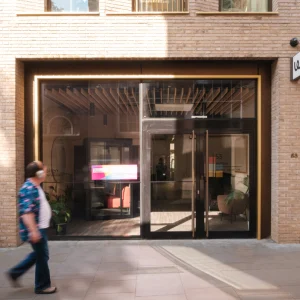30 St Mary Axe
Foster and Partners
London 2004
Skyscrapers would never be the same again. When 30 St Mary Axe, to give the 40-storey Gherkin its proper name, was completed in 2004, the glass skyscraper became an icon – in this case one that redefined a city’s image. Before the Gherkin, the skyscraper, at least outside China and the Gulf, had twice been declared dead – in the 1980s, when office developers built wide ‘groundscrapers’ to accommodate electronic trading floors, and again after 9/11.
After the Gherkin, the skyscraper was back, but had to be a sculptural landmark with green credentials. It was the starting gun that unleashed a wave of them across London, including Rafael Viñoly’s ‘Walkie-Talkie’ in Fenchurch Street, BFLS’s also curvy Strata (‘The Razor’) in Elephant and Castle and the ultimate – Renzo Piano’s Shard at London Bridge. (The Gherkin also started the London habit of giving skyscrapers silly nicknames).
In 2000, The City approved Norman Foster’s 180m-high design for the Baltic Exchange site, cleared by an IRA bomb, partially because developer Swiss Re threatened to quit London if they couldn’t build a skyscraper there, and partly because Canary Wharf, free of central London’s conservation constraints, was building big and bleeding global financial corporations away from the Square Mile.
High-tech and Post-modernism had already dismissed the paradigm of the International Style rectilinear glass tower, but now parametric computer modeling enabled newer shapes. In the 1970s, Foster had worked with Buckminster Fuller on the Climatroffice concept of enclosing a building in an exterior bubble. The Gherkin’s steel-frame diagrid shell, engineered by Arup, is effectively that. But it also shares the vertical load of the floors with the core, which could be steel rather than concrete. Skyscrapers must resist lateral wind forces and a circular cross section deflects them, but the Gherkin design went further, curving vertically as well, increasing its aerodynamism and creating its simple, elegant yet unprecedented form. Wedge-gaps in the concrete floors are rotated five degrees clockwise with each storey, creating helical voids, defined by stripes of darker glass set into the diagrid’s 5,500 triangles, as distinctive as a barber’s pole. Only the Gherkin’s horizontal circular glass apex and the platform below it curve. The design led the Stirling Prize panel in 2005 to agree unanimously for the first time.
Foster went on to wow New York with the Gherkin’s sister, the Hearst Building, designed with the same principles but a different shape. Arguably, his starchitect factor broke the American monopoly on skyscraper design in the world’s greatest high-rise city, now host to projects by Piano, Rem Koolhaas, Jean Nouvel and Richard Rogers. Back in London, the Gherkin became a scene in an on-going power-play between titans of architecture. Rogers’ Lloyds Building was The City’s previous high-rise icon, but the Gherkin made its high-tech look old hat, and thrusts almost 100m over it. Rogers is set to have the last laugh because his ‘Cheesegrater’ nearby will eclipse it.
The Gherkin remains a wildly popular building and a symbol of London as synonymous as Big Ben. But Ken Shuttleworth of Make, who claimed the design was his when a Foster partner, has declared the glass skyscraper dead. That isn’t the case yet, although Nouvel’s Torre Agbar in Barcelona – completed a year after the Gherkin and sharing its suggestive form – has a concrete shell punctuated with random windows. Other sorts of structures are now jostling into London’s skyline action – Anish Kapoor and Cecil Balmond’s Orbit is under construction, and Donis’ London Arch may follow. Even when iconic glass towers have had their day, the Gherkin will leave a legacy of high drama.







